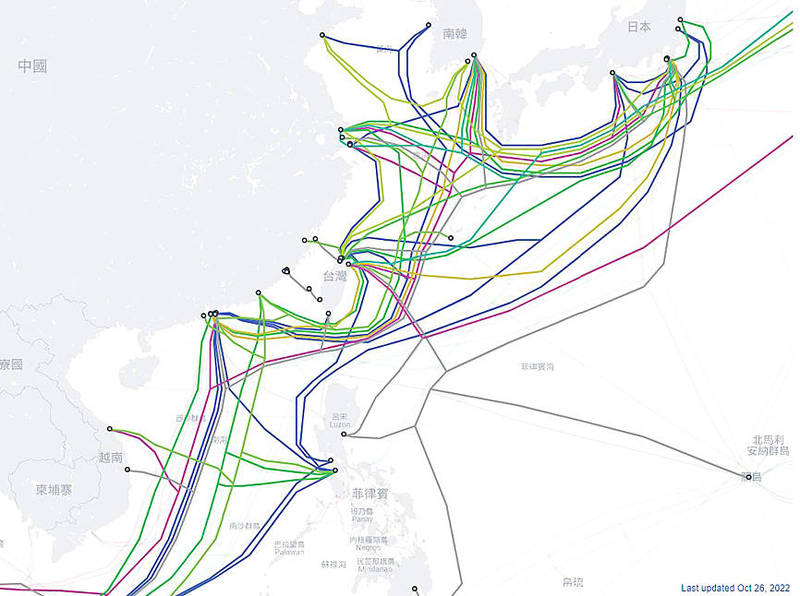《TAIPEI TIMES》 Subsea cables in China’s crosshairs

A map shows undersea Internet cable connections in East Asia. Photo: Screen grab from TeleGeography
ACHILLES’ HEEL? Taiwan’s contingency plans include tapping satellite systems to ensure that an attack on undersea infrastructure would not cut Internet access
/ Bloomberg
Surging tensions with China have prompted Taiwan to boost its military defenses. Now it is heeding the lessons of the war in Ukraine to address one of its bigger weakness: the fragile undersea infrastructure that connects the nation to the Internet.
Taiwan has 14 subsea cables — many little wider than a garden hose — stretching thousands of kilometers and directly linking Asian nations including China to the US and other parts of the world. That is a vulnerability the government, which sees any interruption as potentially destabilizing, wants to minimize.
A disruption in a conflict with China could result in Taiwan getting cut off from the world, similar to what happened to the Pacific Island nation of Tonga earlier this year when a volcanic eruption left it without Internet access for more than a month.
“Undersea cables are a serious Achilles’ heel to Taiwan,” said Kenny Huang (黃勝雄), chief executive officer at the Taiwan Network Information Center, a nonprofit organization partially owned by the government.
It is not just a concern in Taipei. With US-China ties under strain, defense strategists around the world are looking carefully at the risks facing the estimated 1.3 million kilometers of subsea cables that nearly all Internet traffic passes through and planning contingencies for how to deal with the risk of lost access.
The government knows those risks well: An undersea earthquake in 2006 cut eight cables, which took weeks to repair and caused disruptions to the Internet, banking services and cross-border trading that was felt as far away as Singapore.
For President Tsai Ing-wen (蔡英文), the China threat is rising: Chinese President Xi Jinping (習近平) said at the opening of the Chinese Communist Party congress this month that “reunification” with Taiwan “must be realized and it can without a doubt be realized.”
And the Chinese general who led the military command responsible for Taiwan was rewarded by Xi with the post of vice chair of the Chinese Central Military Commission.
In response to the increasing threat, Taiwan is this year to start to incorporate communication breakdowns into its frequent war drills. In the short term, it is also to spend NT$550 million (US$17.11 million) on a plan to bolster existing mobile infrastructure, including submarine cables, and accelerate the deployment of 5G mobile network base stations through 2024.
“False information can easily flow and cause social chaos,” Minister of Digital Development Audrey Tang (唐鳳) told Bloomberg. “We realize that whether Taiwan is under military aggression or encounters emergencies such as natural disasters, it is very important to maintain high-quality, instant communication.”
In the longer term, Tang said Taiwan wants to improve access to communications satellites and has put together a proposal to tap high-speed satellite systems in an emergency.
That plan was partly inspired by Ukraine’s response to Russia’s invasion.
Within days of Russia’s attacks, Tesla CEO Elon Musk’s orbiting broadband provider Starlink activated services in Ukraine, extending a communications lifeline in occupied areas and impressing even US military officials, who said such capabilities were difficult to defeat.
“If you asked me about using satellites last year, I’d say it’s impossible,” Huang said. “But after we learned from the lesson of the Ukraine war, I’d say we need to make the impossible possible.”
It is not clear if the world’s richest man would come to Taiwan’s aid, after he voiced support for Taiwan to become a “special administrative zone” under Chinese rule, comments that were quickly criticized in Taipei and applauded in Beijing.
Officials at SpaceX, which operates Starlink, did not respond to e-mailed requests for comment.
US House of Representatives Speaker Nancy Pelosi’s visit to Taipei in August triggered a wave of cyberattacks 23 times stronger than anything Taiwan had seen in a single day as Chinese warships prepared for drills off its shores.
The disruptions from those cyberattacks were minor, but a move to sever the nation’s subsea fiber cables, which cross disputed waters claimed by China, could be catastrophic. Sustained damage to Taiwan’s cables could crush a digital economy set to reach NT$6.5 trillion by 2025, along with any ambition to become a high-tech hub.
Tonga, a Pacific island nation of about 106,000 people, was left almost entirely cut off from the rest of the world for more than a month when its single international cable was damaged in a volcanic eruption earlier this year.
Residents of the Shetland Islands, the northernmost region of Scotland, last week lost access to mobile and broadband for a few days after cuts to a cable connecting them to the mainland.
Police boosted patrols to reassure residents during the outage, which cable operator Faroese Telecom said was likely the result of a fishing accident, the BBC reported.
TeleGeography, a market research and consulting firm that produces a regularly updated map of the world’s subsea cables, said the data lines can be prone to damage or breaks for reasons ranging from anchor drag to underwater landslides. They have even been seen, on rare occasions, to be the target of shark bites.
In developed nations with multiple systems, the public would not notice the impact of a single cut, as data can be quickly rerouted, but while acts of malice are rare, defense officials are increasingly acknowledging the threat.
As Russian President Vladimir Putin massed troops along Ukraine’s border earlier this year, the head of the British armed forces told the Times that a “phenomenal” buildup of Russian submarine activity threatened underwater cables, and said an attack on them would be an act of war.
France this year rolled out a strategy to defend against “seabed warfare” with deep-sea capabilities, including underwater drones and robots.
With regard to Taiwan, however, Chinese Ambassador to the US Qin Gang (秦剛) in August said that “people are over-nervous”’ about the risk of an attack.
Nevertheless, Taiwan’s rush for new capacity underscores another geopolitical tension.
Of the more than 500 subsea cables globally, according to a Bloomberg analysis, US companies own all or part of 22 percent of them, while China has a small, but growing stake of 4 percent.
One method of ensuring Internet resilience is to build more cables. From 2017 to 2019, international bandwidth used by global networks more than doubled, TeleGeography data showed.
Google, for example, spent more than US$2 billion on its network infrastructure in the Asia-Pacific region in the decade since 2010.
However, that is getting harder as regulations become more cumbersome and the US-China standoff worsens.
Amid a global campaign to block Huawei Technologies Co from supplying 5G wireless networks, the administration of former US president Donald Trump pushed so-called “clean cables” to ensure China could not subvert the global Internet for intelligence gathering.
Since then, at least four projects directly linking the US with Hong Kong were forced to withdraw licensing bids amid US national security concerns, although one backed by Meta Platforms later won approval after agreeing to route the system through Taiwan.
“You build as much diversity as you can and this is partly why you see us investing into all the submarine cables, because ultimately the best way of getting reliability is redundancy in the cable system, so you build as much as you can,” Google vice president Bikash Koley said.
However, the possibility of severed cables is a threat many nations still need to address.
As the host of about 40 undersea cables, Singapore is setting up a cybermilitary force to meet threats in the digital domain, including to physical infrastructure.
Could bad actors try to cause a “digital blackout so that the target country is literally cast into darkness. I think, yes,” Singaporean Minister of Defense Ng Eng Hen (黃永宏) said in June. “It’s not just the stuff of good novels.”
新聞來源:TAIPEI TIMES

















